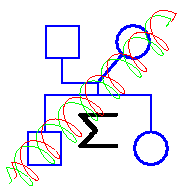
2.
At one of the loci of the rhesus blood group system, there
are 2 alleles C and c.
a) In the simplest test, with only anti-C reagent,
C is dominant to c. In a test of 1000 people, 160 are C-negative
(genotype cc). Assuming Hardy-Weinberg Equilibrium, estimate the
frequency of the c allele, and the variance
of your estimator.
b) An anti-c reagent now becomes available, so that C and c are
codominant. It is found that 400 individuals are CC and 440 are Cc.
How does this change your estimate of the frequency of the c allele?
And of the variance of the estimator?
3. (Example, due to Weir.)
Suppose a population consists of a mixture of two randomly-mating
subpopulations of equal size. Consider a locus with three codominant
alleles. In one subpopulation, the three alleles have frequencies
p=0.6, q=0.3,and r=0.1, while in the other subpopulation they are
p=0.4, q=0.1, r=0.5. Which genotypes have a smaller frequency than they
would have in a single random-mating population with the same
overall allele frequencies?
4. In a subdivided population, the proportion of individuals in
subdivision i is ai. In subdivision
i, at a locus with
two alleles A and B, the frequency of allele A is qi,
and within each subdivision the genotypes are in Hardy-Weinberg
proportions.
Let q = sumi ai qi and let
V = sumi ai (qi -q )2.
Find the frequencies of the three genotype AA, AB and BB in terms
of q and V.
| UW - Statistics: Wednesday, 24-Jul-19 | Contact: Elizabeth Thompson <eathomp@u.washington.edu> |